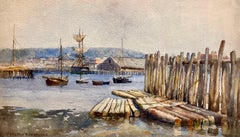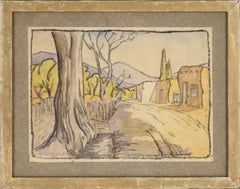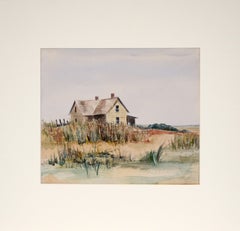Carlton Theodore Chapman Drawings and Watercolor Paintings
American, 1860-1925
Born in New London, OH on Sept. 18, 1860, Carlton Chapman studied in New York City at the National Academy of Design and the Art Students League, and in Paris at Académie Julian.
He was a resident of Los Angeles in 1912-18. He died in New York City on Feb. 12, 1925.
Member: National Academy and California Art Club.
Exhibition: World's Columbian Expo (Chicago), 1893 (award);
Atlanta Expo, 1895 (award);
Pan-American Expo, Buffalo, 1901 (medal);
Albright Gallery (Buffalo), 1906;
Kanst Gallery (LA), 1912.
Collections: Toledo Museum; Brooklyn Institute.to
1
Overall Width
to
Overall Height
to
1
1
1
1
1
1
1
1
1
1
1
1
2
971
401
279
278
1
1
Artist: Carlton Theodore Chapman
New England Fort
By Carlton Theodore Chapman
Located in Fredericksburg, VA
This c. 1900 watercolor by Carlton T. Chapman depicts a quiet harbor scene with moored sailing vessels and weathered wooden docks extending into calm blue water. Known for his mariti...
Category
Early 20th Century American Impressionist Carlton Theodore Chapman Drawings and Watercolor Paintings
Materials
Paper, Watercolor
Related Items
Road at the Edge of Town, Landscape
Located in Soquel, CA
Watercolor of a village by Artemis Wilhelm (American, 20th Century). Bold pastel outlines create solid shapes, filled with watercolor to create tone an...
Category
Mid-20th Century American Impressionist Carlton Theodore Chapman Drawings and Watercolor Paintings
Materials
Paper, Pastel, Watercolor
$372 Sale Price
20% Off
H 12 in W 15 in D 0.75 in
Farmhouse by the Sea - Original Watercolor on Paper
Located in Soquel, CA
Farmhouse by the Sea - Original Watercolor on Paper
Tranquil landscape of a seaside farmhouse on the sand surrounded by coastal plants, in soft neutral watercolors. A distant ocean s...
Category
Late 20th Century American Impressionist Carlton Theodore Chapman Drawings and Watercolor Paintings
Materials
Paper, Watercolor
"Train Station, " Max Kuehne, Industrial City Scene, American Impressionism
By Max Kuehne
Located in New York, NY
Max Kuehne (1880 - 1968)
Train Station, circa 1910
Watercolor on paper
8 1/4 x 10 1/4 inches
Signed lower right
Provenance:
Private Collection, Illinois
Max Kuehne was born in Halle, Germany on November 7, 1880. During his adolescence the family immigrated to America and settled in Flushing, New York. As a young man, Max was active in rowing events, bicycle racing, swimming and sailing. After experimenting with various occupations, Kuehne decided to study art, which led him to William Merritt Chase's famous school in New York; he was trained by Chase himself, then by Kenneth Hayes Miller. Chase was at the peak of his career, and his portraits were especially in demand. Kuehne would have profited from Chase's invaluable lessons in technique, as well as his inspirational personality. Miller, only four years older than Kuehne, was another of the many artists to benefit from Chase's teachings. Even though Miller still would have been under the spell of Chase upon Kuehne's arrival, he was already experimenting with an aestheticism that went beyond Chase's realism and virtuosity of the brush. Later Miller developed a style dependent upon volumetric figures that recall Italian Renaissance prototypes.
Kuehne moved from Miller to Robert Henri in 1909. Rockwell Kent, who also studied under Chase, Miller, and Henri, expressed what he felt were their respective contributions: "As Chase had taught us to use our eyes, and Henri to enlist our hearts, Miller called on us to use our heads." (Rockwell Kent, It's Me O Lord: The Autobiography of Rockwell Kent. New York: Dodd, Mead and Co., 1955, p. 83). Henri prompted Kuehne to search out the unvarnished realities of urban living; a notable portion of Henri's stylistic formula was incorporated into his work.
Having received such a thorough foundation in art, Kuehne spent a year in Europe's major art museums to study techniques of the old masters. His son Richard named Ernest Lawson as one of Max Kuehne's European traveling companions. In 1911 Kuehne moved to New York where he maintained a studio and painted everyday scenes around him, using the rather Manet-like, dark palette of Henri.
A trip to Gloucester during the following summer engendered a brighter palette. In the words of Gallatin (1924, p. 60), during that summer Kuehne "executed some of his most successful pictures, paintings full of sunlight . . . revealing the fact that he was becoming a colorist of considerable distinction." Kuehne was away in England the year of the Armory Show (1913), where he worked on powerful, painterly seascapes on the rocky shores of Cornwall. Possibly inspired by Henri - who had discovered Madrid in 1900 then took classes there in 1906, 1908 and 1912 - Kuehne visited Spain in 1914; in all, he would spend three years there, maintaining a studio in Granada. He developed his own impressionism and a greater simplicity while in Spain, under the influence of the brilliant Mediterranean light. George Bellows convinced Kuehne to spend the summer of 1919 in Rockport, Maine (near Camden). The influence of Bellows was more than casual; he would have intensified Kuehne's commitment to paint life "in the raw" around him.
After another brief trip to Spain in 1920, Kuehne went to the other Rockport (Cape Ann, Massachusetts) where he was accepted as a member of the vigorous art colony, spearheaded by Aldro T. Hibbard. Rockport's picturesque ambiance fulfilled the needs of an artist-sailor: as a writer in the Gloucester Daily Times explained, "Max Kuehne came to Rockport to paint, but he stayed to sail." The 1920s was a boom decade for Cape Ann, as it was for the rest of the nation. Kuehne's studio in Rockport was formerly occupied by Jonas Lie.
Kuehne spent the summer of 1923 in Paris, where in July, André Breton started a brawl as the curtain went up on a play by his rival Tristan Tzara; the event signified the demise of the Dada movement. Kuehne could not relate to this avant-garde art but was apparently influenced by more traditional painters — the Fauves, Nabis, and painters such as Bonnard. Gallatin perceived a looser handling and more brilliant color in the pictures Kuehne brought back to the States in the fall. In 1926, Kuehne won the First Honorable Mention at the Carnegie Institute, and he re-exhibited there, for example, in 1937 (Before the Wind). Besides painting, Kuehne did sculpture, decorative screens, and furniture work with carved and gilded molding. In addition, he designed and carved his own frames, and John Taylor Adams encouraged Kuehne to execute etchings. Through his talents in all these media he was able to survive the Depression, and during the 1940s and 1950s these activities almost eclipsed his easel painting. In later years, Kuehne's landscapes and still-lifes show the influence of Cézanne and Bonnard, and his style changed radically.
Max Kuehne died in 1968. He exhibited his work at the National Academy of Design, the Art Institute of Chicago, the Carnegie Institute in Pittsburgh, the Memorial Art Gallery of the University of Rochester, and in various New York City galleries. Kuehne's works are in the following public collections: the Detroit Institute of Arts (Marine Headland), the Whitney Museum (Diamond Hill...
Category
1910s American Impressionist Carlton Theodore Chapman Drawings and Watercolor Paintings
Materials
Paper, Watercolor
$2,800 Sale Price
20% Off
H 13.5 in W 15.5 in
Rowboat Outing - Fall Landscape with Rowboats in Watercolor on Paper
Located in Soquel, CA
Rowboat Outing - Fall Landscape with Rowboats in Watercolor on Paper
Serene lakeside landscape by an unknown artist (20th Century). Two birch trees with bright yellow leaves are gro...
Category
Mid-20th Century American Impressionist Carlton Theodore Chapman Drawings and Watercolor Paintings
Materials
Paper, Watercolor
$495
H 29.5 in W 23.5 in D 0.75 in
Autumn by the Stream, Early 20th Century Landscape Watercolor
Located in Soquel, CA
Subtly-toned autumn scene by Sydney Cooper (American, 19th-20th C.). This is piece is composed of subdued fall tones - tan, pale green, and coppery reds. A blue stream cuts through t...
Category
Early 20th Century American Impressionist Carlton Theodore Chapman Drawings and Watercolor Paintings
Materials
Paper, Watercolor
$540 Sale Price
20% Off
H 21.5 in W 17.5 in D 0.75 in
"Monhegan Island, Maine, " Edward Dufner, American Impressionism Landscape View
By Edward Dufner
Located in New York, NY
Edward Dufner (1872 - 1957)
Monhegan Island, Maine
Watercolor on paper
Sight 16 x 20 inches
Signed lower right
With a long-time career as an art teacher and painter of both 'light' and 'dark', Edward Dufner was one of the first students of the Buffalo Fine Arts Academy to earn an Albright Scholarship to study painting in New York. In Buffalo, he had exchanged odd job work for drawing lessons from architect Charles Sumner. He also earned money as an illustrator of a German-language newspaper, and in 1890 took lessons from George Bridgman at the Buffalo Fine Arts Academy.
In 1893, using his scholarship, Dufner moved to Manhattan and enrolled at the Art Students League where he studied with Henry Siddons Mowbray, figure painter and muralist. He also did illustration work for Life, Harper's and Scribner's magazines.
Five years later, in 1898, Dufner went to Paris where he studied at the Academy Julian with Jean-Paul Laurens and privately with James McNeill Whistler. Verification of this relationship, which has been debated by art scholars, comes from researcher Nancy Turk who located at the Smithsonian Institution two 1927 interviews given by Dufner. Turk wrote that Dufner "talks in detail about Whistler, about how he prepared his canvasas and about numerous pieces he painted. . . A great read, the interview puts to bed" the ongoing confusion about whether or not he studied with Whistler.
During his time in France, Dufner summered in the south at Le Pouleu with artists Richard Emil Miller...
Category
Early 20th Century American Impressionist Carlton Theodore Chapman Drawings and Watercolor Paintings
Materials
Paper, Watercolor
Watercolor of the Oak Tree by Allen Tucker
By Allen Tucker
Located in Hudson, NY
Landscape watercolor by Allen Tucker of an oak tree. This piece, along with several others, was gifted to Una Brage, a friend of the artist in the 1930s.
More about this artist:
Allen Tucker, was an architect and painter so influenced by Vincent Van Gogh that he was called "Vincent in America". (Gerdts 291) Robert Henri and Maurice Prendergast were also credited as having an influence on Tucker's brushwork and compositions, the latter decisively. However, as his painting evolved, he did not fit into any tidy slot for description and was known as an individualist not easily categorized in American art history.
Tucker was born in Brooklyn in 1866 and graduated from the School of Mines of Columbia University with a degree in architecture and took a job as an architectural draftsman in the architectural firm of McIvaine and Tucker, his fathers business. During that time, he studied painting at the Art Students League with Impressionist John H. Twachtman, but it was not until around 1904, when he was 38, that Tucker became a full-time painter, leaving architecture behind. Many of his early canvases were classically Impressionistic with poplar trees resembling those of Van Gogh and haystacks and corn shocks...
Category
Early 20th Century American Impressionist Carlton Theodore Chapman Drawings and Watercolor Paintings
Materials
Paper, Watercolor
Mountain Lake Landscape with Boats
Located in Soquel, CA
Beautiful watercolor landscape in a palette of deep greens and blues, of a boat pulled up on a lake shore with layered tree lines in the background Signed "E. P. Blackburn" lower ri...
Category
1990s American Impressionist Carlton Theodore Chapman Drawings and Watercolor Paintings
Materials
Watercolor, Archival Paper
Harvest Time The Hills of Mt Tamalpais near Lake Bon Tempe 1890s
Located in Soquel, CA
Harvest Time The Hills of Mt Tamalpais near Lake Bon Tempe 1890s
The Hills around San Rafael in the 19th century were a time of work and play as seen in this watercolor near Lake Bon...
Category
Late 19th Century American Impressionist Carlton Theodore Chapman Drawings and Watercolor Paintings
Materials
Watercolor, Illustration Board, Laid Paper
$1,440 Sale Price
20% Off
H 21.75 in W 11.5 in D 0.07 in
Orange Poppies in a Vase, Modernist Still Life in Watercolor on Paper
Located in Soquel, CA
Orange Poppies in a Vase, Modernist Still Life in Watercolor on Paper
A vibrant watercolor still life with a vase filled with orange poppies on a carnation pink background with abstract leaves of teal blue and purple, by California artist, Lucile Marie Johnston (1907-1994, American).
Signature, "L. Johnston '74" at the bottom left and "Lucile Johnston" on the back. Presented in a new cream mat with foam core backing.
Mat size: 24"H x 20"W
Paper size: 16"H x 12"W
Born in Santa Rosa, California on May 26, 1907, Lucile Johnston settled in Glendale 1930-1939, later moving to Carmel and then Pacific Grove in Monterey County, California where she remained. she managed Marsh's Oriental Antiques Shop...
Category
20th Century American Impressionist Carlton Theodore Chapman Drawings and Watercolor Paintings
Materials
Paper, Watercolor
$850
H 24 in W 20 in D 0.25 in
Rocks and Sea
By Robert Swain Gifford
Located in Bryn Mawr, PA
Born on a small island near Martha's Vineyard, R. Swain Gifford and his family moved to the New Bedford, Massachusetts, area when he was two years old. The Dutch marine painter Alber...
Category
Late 19th Century American Impressionist Carlton Theodore Chapman Drawings and Watercolor Paintings
Materials
Paper, Watercolor
Boat Scene
By Fairfield Porter
Located in Miami, FL
Watercolor on heavy paper
work is unframed
Signed by artist in pencil, lower right verso.
Property from the estate of Anne E. C. Porter, with the estate stamp, verso.
...
Category
1950s American Impressionist Carlton Theodore Chapman Drawings and Watercolor Paintings
Materials
Watercolor, Paper


